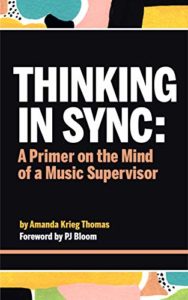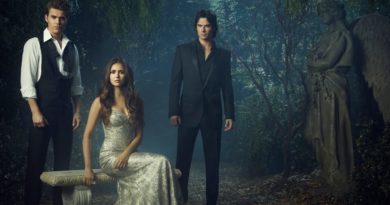Amanda Krieg Thomas Helps You Get In Sync With Music Supervisors, Part I
Veteran music supervisor Amanda Krieg Thomas has seen a lot in this industry. A leading music supervisor for such shows as The Americans, Claws, The Assassination of Gianni Versace: American Crime Story, Pose, The Politician and 9-1-1, fortunately for all of us, Thomas is passionate about sharing her knowledge.
Earlier this year Thomas released her ebook, Thinking In Sync: A Primer on the Mind of A Music Supervisor. (No Kindle? Download the free app to read it on your computer or phone.) Designed as an introductory guide on the mechanics of sync licensing and working with music supervisors, Thomas distills down her 10 years of experience in the industry into concrete things you should – and shouldn’t – do if you want to achieve success in sync.
We sat down with Amanda for a wide-ranging conversation touching on the role of a music supervisor, how the industry has changed, the art of clearance, and – of course – some valuable insights for artists, managers, and sync reps on how to work with music supervisors.
Part I of our conversation is below. In Part II, Thomas dives in a bit more on the career of music supervision, gives her tips on how to submit music to supervisor and more helpful hints for those hoping to achieve success in sync.
The True Role of a Music Supervisor
While the term “music supervisor” can be found all over the internet these days, a surprisingly small number of platforms use it correctly. Thomas wants to do her part to help people understand how music supervisors really operate, to address a lot of misconceptions out there about the role.

The biggest misconception she would love to clear up? The idea that music supervisors pick all the songs in a show or movie.
Because really, the job of a music supervisor is to help the creator fulfill their vision – which can truly be anything. A music supervisor provides their consulting expertise – always with the budget in mind – around choices like genres, composers, custom recordings, on-screen performances and many more details about how music is used. But decisions are ultimately made by creators in service of the storytelling.
“Even when we are working very closely and they want ideas from us for every single scene, at the end of the day, the creator is still going to be the one picking the song that ends up in there,” says Thomas.
The reality of music supervision is that it’s all about collaboration. And very rarely about the personal taste of the supervisor. She cautions any aspiring music supervisor who will get hung up on that.
“Our job as music supervisors is to help with the journey to that decision,” says Thomas. “Sometimes they pick something we send, but sometimes we send ideas and that sparks another idea for them. They’re like, ‘Oh, you know you what that makes me think of? This song, I love this song.’”
Understanding and interpreting the creator’s vision is a critical skill for a music supervisor. Sometimes a showrunner or director can be extremely vocal and explicit, both about what they want and what they don’t want. Sometimes songs are integral to the story and written into the script. (Think the Baby Driver soundtrack.)
Other times, a music supervisor has to tease this info out of them and listen carefully for clues. Are they thinking about the music on a character level? Is time period important to them?
“I like asking ‘How do you want people to feel here?’” says Thomas. “Sometimes I’ll put together five options that are all a little bit different, deliberately, and then see what they gravitate towards.”
People skills and creative problem solving become especially important when a music supervisor needs to reconcile all of the different opinions of the people involved in a production. Particularly when an expensive creative choice doesn’t fit within the budget allocated.
“Sometimes you’re in the middle and navigating that in a way that’s respectful to a lot of different people is hard,” says Thomas, highlighting a skill that is sometimes overlooked and undervalued in an experienced music supervisor.
The Art of the Job
Beyond those all-important people skills, a successful music supervisor is really able to tap into both sides of their brains. The creative side of the equation gets a lot of attention – people imagine music supervisors are just sitting around listening to music all day, finding that one perfect song.
In reality, there’s a lot of detail-oriented work in music supervision, and lots of spreadsheets. From spotting sessions to identify all the potential music cues, managing contracts, tracking budgets and much more, music supervisors have to stay on top of it all. If they’re working in television, all of this will be on some pretty tight timeframes, perhaps as little as one week per episode.
Clearance – the process of contacting whoever owns the rights to the music (artists, songwriters, publishers, labels) to secure the necessary permissions and licenses to feature a piece of music in media – is a critical aspect of music supervision, but not widely understood outside the profession.
From the detective work of figuring out actually who controls rights to the music to making sure all the i’s are dotted and t’s crossed on the final contracts and cue sheets, Thomas believes clearance is an art unto itself.

And while music supervisors are constantly being pitched music, many people don’t realize that supervisors have to be experts in pitching potential syncs to artists (and their teams), as well. Particularly with artists who are selective about where their music appears.
“That initial ‘sell’ to an artist is definitely part of the art, especially when you’re working on a new show that’s unproven,” points out Thomas, who has had to get approvals from artists like Mark Knopfler, Prince, Janet Jackson, U2, Patti Smith, Talking Heads and many other music legends. “They can be choosy, so you have to put your best foot forward and really sell them on why this show and this scene are a great fit for their music.”
Not only are writing skills key, but knowing how a potential artist/their team operates is important. Who is the best contact to work through? Do they only read emails on their phone, where brevity works best? Do they only approve uses with a political angle, or deny whenever there is even a mention of violence? Some of this insider intel only comes with experience, and a memory for these kinds of details.
Rising to the Challenge
Finding the right song can truly elevate a scene, but none of that matters if you can’t license it. Researching and finding the correct contacts and thinking strategically about how to make that initial approach can be crucial.
Thomas recalls one such situation with the FX television series Pose. A vibrant period romp through the era of the 80’s New York underground ball culture, creator Ryan Murphy had requested a Grace Jones song for a scene in an early episode. The team was in complete agreement that the iconic artist was a perfect creative fit for the show. (See the full Pose sountrack on Tunefind.)
But Thomas knew this would be a challenge. Jones is very particular about how her music is used, and difficult to contact to submit a licensing request. Plus this was a brand new show, with no proven track record or previous episodes to illustrate Murphy’s vision. With her typical determination, Thomas set out on a 6-month journey to make it happen.
“We ended up finding her modeling agent’s email and reaching out to him with the production stills from the show – these gorgeous, amazing photos of the women in beautiful, colorful couture,” recalled Thomas. “Who is going to appreciate these stunning images, probably? Hopefully? Grace Jones.”
Lo and behold, the agent replied: “He said, ‘I’m sitting next to her on a plane. She’s into this. We’re going to put you in touch with the right people.’ And it worked out,” says Thomas, with a victorious smile. “The episode’s final mix finished a couple days later.”

I've Seen That Face Before
by Grace Jones
from Pose Soundtrack · Season 1 · Episode 2 · Access
Rematch of House Abundance and House Evangelista.
A Music Supervisor’s Worst Nightmare
But it’s not all victory dances in this gig. One little known secret is that many different songs may be auditioned for a scene, with editors cutting together different versions to see what works best. And those early edits likely include songs that haven’t officially been licensed yet. Enter a music supervisor’s worst nightmare.
“It depends on the show and the producer, but there’s always an expectation that when I send something, I’m backing it,” says Thomas. “My reputation is on the line, even if I’m up front that it’s something new or something unproven.”
The “temp love” can be painful – where a creator falls in love with a song that’s been temp’d into the scene – since there’s no guarantee that song can even be cleared, or licensed for a fee that fits the budget. Cue the disappointment.
“There are a few shows that are on very fast schedules, where it comes down to the 11th hour. It’s my job as a supervisor, even if I think something’s going to clear in that 11th hour, to point it out and say, ‘Hey, guys, we have to come up with backups,’” says Thomas. “Fortunately, up until now, usually things come through. There have been a couple of times where they haven’t and we have had to use those backup plans.”
But having an uncleared song make it into the final episode is the true nightmare scenario for many music supervisors. With the lightning fast pace of some television productions, just one crossed wire can be disastrous. Thankfully, this is a very rare occurrence.
“One time no one told us about a cue that was in a cut and the episode aired,” recalled Thomas. “The morning after I was going over everything and realized what had happened. By the end of that day I figured out who owned it and reached out to them and they approved the use, but that was a very scary moment.”
Thomas shares moments like this so people on the other side of the sync licensing equation can understand the pressures of supervision, and what’s at stake.
Tips for Pitching A Music Supervisor
Now we get into the real nitty gritty – the kinds of tips and expertise that you’ll find in Thomas’ book, Thinking In Sync. Lots more wisdom can be found in the book, but we teased out a few highlights from our conversation to share with you here.
You would think we would be past the basics, but Thomas says she still regularly gets emails full of spelling and grammar mistakes, which are clear red flags. She’s also turned off by form emails that are too cold and businesslike, and too transactional.

“Frankly, a big red flag is artists, songwriters, producers, or managers who don’t work in sync at all,” says Thomas. “They’re coming in cold and they’re clearly just trying to create awareness for themselves or their client, but I can tell the relationship is going to be challenging.”
You might assume this is just indie artists, but Thomas has run into this at both ends of the spectrum.
“I will even get emails from managers of giant artists,” says Thomas. “Then I’ll go to clear something, and they’ll be like, ‘This song actually has five publishers, but we can make it happen really easily on the artist side.’ Well, that doesn’t help me. In order to use the song I need all of those publishers to make it happen too!”
While there are definitely supervisors who are happy to help guide an artist and/or their team through the sync licensing process, they are somewhat rare. This isn’t because they don’t want to help; many supervisors simply don’t have time – or the turnaround time in their production schedule – to do this regularly.
Already lost in all this sync jargon? Definitely check out Thomas’ book. She guides readers through topics like splits, recording quality, metadata, plus every step of the clearance process.
The Pitching Roadmap
So, now you’ve read up and are ready to reach out to a music supervisor. How can you put your best foot forward?
“I joke about this in my book,” laughs Thomas. “I think I’ve provided advice that’s universal, but at a bare minimum, you now know exactly how I like things. There’s a complete roadmap.”
Ironically, everybody always jumps straight to the songs, assuming that if a supervisor falls in love with the music that they’ve got it made in the shade. But actually, most music supervisors want to know that you’re sync-savvy and how they will work with you first.
“Personally, I really like when people start by telling me who they are,” shares Thomas. “Are you a label? Are you a manager? Just a little bit about the company, if you’re a company. If you’re a sync agent, just a little bit more about where you’re coming from.”
This can provide Thomas and other music supervisors with key intel on how the business side of the conversation will play out, if and when they ever come back to license a song. Is this a one stop deal or will this be a complex negotiation involving a lot of different approvals? Especially in television, timing can be tight. But never misrepresent yourself – that will only hurt you in the end.
Next, Thomas likes to see people who have done their homework on her shows. Don’t clutter her inbox with a rookie-level email asking what she’s working on – she barely has time to provide that info to the people she already works with regularly.
But actually do your homework. Don’t just look at an IMDB page and take a guess at what a show might sound like. That will backfire. Tunefind can help you here.
“With The Americans, I would get emails all the time saying ‘I’ve got these 80s-inspired tracks that would be great for The Americans!’” recalls Thomas. “Well, that’s nice, but if you looked at the list of songs we’ve used in The Americans on Tunefind, or if you looked at any of the press on the music on the show, you can see it’s all authentic 80s music. Yes, there are many shows where it’s nearly impossible to find information on the music used – especially new shows – and on those it’s understandable to take a shot in the dark like that. But when it’s a show like The Americans or Pose there are a lot of resources and they’re easy to find.”
To Be Continued…
We continue our conversation with Amanda Thomas in part II of our interview. Thomas talks more about her career as a music supervisor, how the industry has changed, and shares some more valuable sync tips for artists and their teams.
More
〉Amanda Krieg Thomas Helps You Get In Sync With Music Supervisors, Part 2
〉Read now: Thinking In Sync: A Primer on the Mind of A Music Supervisor
〉Amanda Krieg Thomas on Tunefind
〉Thomas’ company: Yay Team Productions





Pingback:Amanda Krieg Thomas Helps You Get In Sync With Music Supervisors, Part II - Tunefind
Pingback:Top TV Song Last Week: Out of Control by Oshins, feat. Rosi Golan - Tunefind
Pingback:Top Blog Posts of 2019 - Tunefind